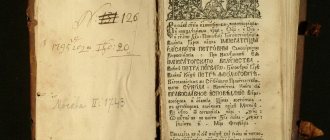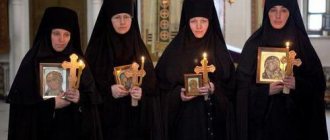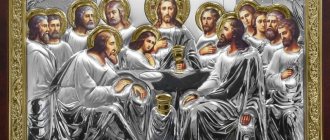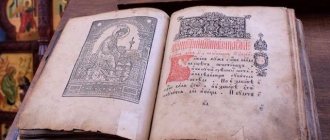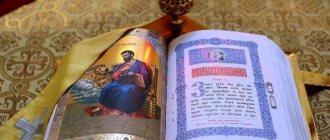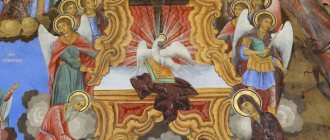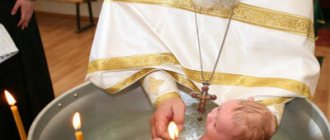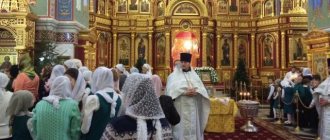The currently popular writer Lyudmila Ulitskaya in her novel “Daniel Stein, Translator” says: “Behaving with dignity and correctly is more important than observing rituals.” She is not alone in this; many people believe that behaving ethically is more important than observing church rituals or adhering to the opinion shared by the Orthodox Church.
In this case, such cornerstones of faith as the recognition of Jesus Christ as the Messiah, the ideas of the Trinity, Atonement and Salvation, etc. are called into question. To prevent this from happening and to prevent the strength of the Christian faith from being questioned, the Church developed and approved special provisions (dogmas) that are not subject to discussion or doubt.
The doctrine of dogmas was developed by ancient scientists and the Fathers of the Church
The history of the word “dogma” comes from ancient literature, but at that time it was not used in the theological sense. Thus, Cicero used the word dogma to designate those well-known doctrines that had the meaning of undeniable truth.
In the same sense, such Christian writers as Origen and Saint Isidore called Socrates the legislator of Attic dogmas, and the teachings of Plato and the Stoics - dogmas. According to Xenophon, dogma is an order of command to which everyone, both commanders and ordinary soldiers, must unquestioningly obey
Xenophon. Bust. The word “dogma” is already found in ancient authors, who define it as an administrative order that should be obeyed without discussion.
The interpretation of the concept of “dogma” from ancient literature migrated to Christian literature. Thus, in the Greek translation of 70 interpreters in the books of the prophet Daniel, Esther, and the books of Maccabees, the word δόγμα is called a royal decree, subject to immediate execution.
In addition, this word also refers to the royal or state law, which is unconditionally binding on every subject.
The word “dogma” is found in the translation of 70 interpreters in the books of the prophet Daniel.
In the New Testament, namely in the Gospel of Luke, the word δόγμα is used to describe Caesar’s order to take a census of the population of the Roman Empire. In the Book of Acts of the Apostles - the royal laws in the epistle to the Collossians and Ephesians - the laws of Moses, which had divine authority.
If we talk about religious dogmas, then first in the book of the Acts of the Apostles, and then in the book of Acts (XV, 20-28) this word denotes those definitions of the church that should have indisputable authority for each of its members.
Hieromartyr Ignatius the God-Bearer of Antioch. Saint Ignatius, together with other Church Fathers, developed in detail the concept of Christian dogma
Such Fathers of the Church as Ignatius the God-Bearer, Cyril of Jerusalem, John Chrysostom, etc. developed the concept of dogma in more detail. According to their writings:
- Dogma is an indisputable divine truth that is given through Divine Revelation. That is why the dogmas of God’s faith are not recognized as a product of speculative human thinking and personal opinion.
- Dogma is the truth that relates to the theory and essence of religion. This differs from the rules of everyday life for a Christian.
- Dogma, as a truth of divine origin, defined and formulated by the Church, is called dogmas of the Church (τά τής έκκλησίας δόγματα), or church dogmas (τά έκκλεσιαστικά δόγματα).
- A dogma is a truth that a Christian must unconditionally acknowledge in order to consider himself a member of the Church.
Dogmatist - a person who strictly follows Christian truths
Often believers and atheists ask: who is a dogmatist? The answer to this question can be found in any encyclopedic dictionary: a dogmatist is a person who always follows church dogmas (dogmas).
In a sense, all Orthodox Christians can be called dogmatists, since the Orthodox Church does not allow them to deviate or change. Catholics and especially Protestants interpret church dogma quite freely, which led over time to the fact that they separated from Orthodoxy, entering into a schism of the Christian Church.
The main purpose of Christian dogmas is to introduce the human mind to the knowledge of God
Dogmas are the doctrinal definition of the Orthodox Church. Their task is to introduce the human mind to the knowledge of God. The basic tenets of Christianity embody three fundamental rules:
- The existence of the Almighty in three persons;
- The incarnation of God's Son into a representative of the human race;
- Delivering humanity from sins.
Video: “Truth, dogma and faith.” At 4 minutes 22 seconds, the author says that the truth was given in the Church initially and cannot change or increase.
The term “dogma” in its proper meaning is used primarily in Christianity and denotes theological, revealed truth, containing the teaching about God and His economy, which the Church defines and professes as an unchangeable and indisputable position of faith.
It should be noted that Orthodoxy is characterized by two approaches to where dogmas are accepted.
Dogma
this is the doctrinal Definition of the Orthodox Church on the issue of its teaching
According to the first approach, only those indisputable provisions of the Orthodox faith that are approved at Ecumenical Councils are called dogmas. On them they receive a dogmatic formulation. The second approach suggests that every indisputable and obligatory provision of Orthodox dogma should be called dogma.
Based on these two approaches, Christian dogmas are divided into:
- General (dogmatic formulations of the Ecumenical Councils) and specific (derived from the general).
- Revealed , that is (discussed and approved at the Ecumenical Councils), and not revealed. The latter are not discussed in detail at ecumenical councils and are not defined in detail, but are recognized by the entire Orthodox Church.
- Pure , based on Divine Revelation and mixed, based not only on such Revelation, but also on natural reason.
In Orthodoxy, dogmas became a response to the distortion of Christian teaching
Orthodox dogma identifies the following properties of dogmas:
- Theological.
- Godliness.
- Churchness.
- General obligation.
The content of these properties is revealed above in relation to the writings of the Church Fathers dedicated to dogmas. It should be noted that each religious movement may have its own dogmas.
So, for example, the Orthodox recognize the dogmas adopted by the resolutions of the Ecumenical Councils as a response to certain fundamental distortions of church teaching. Catholics recognize the need for new dogmas to emerge without this condition.
The dogma of the Church is not subject to condemnation or change.
The dogma of the Church is a doctrinal truth that is not subject to discussion. That is why, if a conscious departure from a dogma is recorded in the form of its complete rejection or a different interpretation, we can talk about the presence of heresy in the judgments of this or that person.
Thus, answering the question: who is a dogmatist, we can say that this is the person who does not deviate from the teachings of the Church, shares and observes all its dogmas.
Icon Symbol of Faith. Orthodox dogmas are contained in the Creed and the Catechism
The dogmatic provisions of Orthodox teaching are set out in the Creed. In addition, they can also be found in the Catechism and educational literature on the Law of God. Dogmas are designed to help every person have an accurate, unambiguous understanding of God and his relationship with the world, and clearly understand where Christianity ends and heresy begins.
That is why the doctrinal truths of Catholicism and Protestantism recognize different provisions than in Orthodoxy, which led to a split between the largest Christian denominations.
Theological opinion
Of course, the experience of Christianity is broader and fuller than the dogmas of the Church. After all, only the most necessary and essential for salvation is dogmatized. There is still a lot that is mysterious and unrevealed in the Holy Scriptures. This determines the existence of theological opinions .
Theological opinion is not a general church teaching, like dogma, but is the personal judgment of a particular theologian. The theological opinion must contain a truth that is at least consistent with Revelation.
Of course, any arbitrariness in theology is excluded. The criterion for the truth of this or that opinion is its agreement with the Holy Tradition, and the criterion for admissibility is not a contradiction with it. Orthodox and legitimate theological opinions and judgments should be based not on logic and rational analysis, but on direct vision and contemplation. This is achieved through the feat of prayer, through the spiritual formation of a believing person...
Theological opinions are not infallible. Thus, in the writings of some Church Fathers there are often erroneous theological opinions, which nevertheless do not contradict the Holy Scriptures.
The main dogmas of Christianity (there are 12 of them), adopted at the Ecumenical Councils, are recognized by Orthodoxy
Orthodoxy is characterized by the presence of a strict and distinct religious consciousness. This is its undoubted advantage over Catholicism and Protestantism.
At the same time, Orthodox Christians must always remember that dogma does not mean the introduction of new truths regarding God, since Jesus Christ gave us Christian teaching in its entirety. Dogmas only outline the boundaries of our interpretation of such teaching, and also reveal the holistic attitude of the Church to newly emerging issues and circumstances.
Icon of Christ and 12 Apostles. Jesus Christ is the head of the Christian Church, therefore its teaching is complete and cannot be changed
Orthodoxy recognizes 12 dogmas adopted by the Ecumenical Councils of the 4th century. Their list is as follows:
- Dogma of the Holy Trinity. They contain a definition of the One God of Christians, who represents three Persons in One - Father, Son and Holy Spirit.
- Dogma of the Fall. Contains the concept of the original sin of Adam and Eve and its consequences for humanity, which after the Fall was expelled from Paradise and can now only be saved through repentance and prayer to the Lord.
- Dogma of the Redemption of mankind from sin. Contains the concept of atonement for original human sin through the appearance of Jesus Christ on earth and his suffering on the Cross.
- Dogma of the Incarnation of our Lord Jesus Christ. He speaks of the mysterious union of two natures - divine and human in the person of the incarnate Son of God, Jesus Christ.
- Dogma of the Resurrection of our Lord Jesus Christ. It says that Our Lord Jesus Christ died after the crucifixion and suffering on the cross, but was resurrected. This is the most important Christian dogma and belief in the resurrection of Christ - distinguishes a Christian from followers of all other religions.
- Dogma of the Ascension of our Lord Jesus Christ. It says that after his Resurrection, Christ ascended to Heaven. Thus, Christ, through his death, Resurrection and Ascension, gave people the opportunity to receive the Grace of God and be saved through communion, repentance and prayer.
- Dogma of the Second Coming of the Savior and the Last Judgment. It speaks of the Second Coming of Christ to earth. The Savior will resurrect all the dead and will carry out the Last Judgment, after which the righteous will go to heaven and sinners to hell.
- Dogma of the unity, conciliarity of the Church and the continuity of teaching and priesthood in it. The Nicene-Constantinopolitan Creed conveys this: “I believe in one, holy, catholic and apostolic Church.” Allows you to distinguish Itsin Church from other human communities and other non-Orthodox Churches.
- Dogma about the general resurrection of people and the future life. It says that after the Second Coming of Christ all people will be resurrected, enter the Kingdom of Heaven and will abide there with the Lord.
- Dogma of the two natures of the Lord Jesus Christ. Adopted at the IV Ecumenical Council in Chalcedon. He says that Christ represents one Person and one Hypostasis - not into two faces cut or divided, but one and the same Son and Only Begotten, God the Word, the Lord Jesus Christ.
- The dogma of two wills and actions in the Lord Jesus Christ. Adopted at the VI Ecumenical Council in Constantinople. The dogma says that in Christ there is one will and one action, while the Divine and real human nature in him differ.
- Dogma on icon veneration. Adopted at the VII Ecumenical Council in Nicaea. Allows the veneration of holy icons, while indicating that it is necessary to prevent their deification, since a Christian is not devoted to the icon itself, but to God and His saints depicted on the icon.
Why are dogmas needed?
Dogmatism versus dogma
The word “dogma” (and its derivatives) is very unlucky in our language. For secular people, this word has a distinctly negative character. In everyday language, it has already become part of speech cliches, such as “science has refuted religious dogmas” or “Christian dogmas fetter modern man.” People who use such cliches usually find it difficult to name the dogmas in question and indicate what their essence is. What is dogmatism
for non-church people? As far as can be understood, it means a refusal to think, a refusal to take part in the consideration of anything that might shake established opinions, that is, intellectual dishonesty and closed-mindedness.
In this understanding, dogmatism is undoubtedly a bad quality: it is one of the manifestations of pride - the refusal to admit one’s opinion is erroneous, even when this erroneousness is completely obvious. People tend to make mistakes, and unreasonable people tend to insist on their mistakes. Dogmatism of this kind is in no way connected with Orthodoxy or with religion in general - atheism in this sense is a dogmatist to all dogmatists; although, of course, believers are not immune from it. However, such “dogmatism” is, at best, very weakly related to dogmatics
Churches. Although these are words with the same root, perhaps the common root is all they have in common. We live in a paradoxical culture that praises reason and refuses to think; extols knowledge - and does not want to know; insists on intellectual openness - and ignores everything that does not fit into her belief system. In this culture, it is generally accepted that spirituality is least of all in need of clear definitions. Is it so? In order to understand why the Church insists so much on its dogmas, a rejection of dogmatism is needed; a certain degree of freedom and openness is needed. What is needed is a willingness to question common opinions; You need - let's use this word - free-thinking to disagree with TV. So, let's try to figure out what dogmas are and why they are so important.
Dogma
in the Church it is called the conciliarly accepted doctrinal position; the most important dogmas are given in the Creed, which is sung at every Liturgy and read every morning by Christians. The dogmas are binding on all members of the Church; if a person does not share them, he is not an Orthodox Christian. This seems incomprehensible to many people. Why should faith have clear and binding boundaries?
About the differences between angels and elves
There are different ways in which elves can be depicted - as wise and beautiful creatures, like Tolkien's elves; in the form of creatures that are stupid and ugly, like Rowling’s house elves; in the form of pointy-eared girls with bows, like in Japanese comics, or in some other way. Any person who ardently insists that true elves are like this and only like this, and that any attempts to portray them in any other way are a disastrous delusion, will seem simply crazy.
Most people agree that elves don't exist - what's the point of arguing about the shape of the ears of fictional creatures? Even if a person believes in elves in a certain sense - that is, he is warmed by the idea that somewhere in remote places or in other dimensions elves exist - any dogma in this belief will seem inappropriate to him. Faith in elves is not at all a matter of life and death: even if a person himself treats it very reverently, he understands that other people get along just fine without it. If they also have some dreams that warm their soul, then these may be completely different dreams. If you have fallen into the wrong views regarding elves, there is no danger for you; if you faithfully adhere to what is right, it promises you nothing. And does it even make sense to talk about right or wrong views on elves? Everyone is free to choose what they like best. Belief in elves is adogmatic.
When we talk not about elves, but, say, about high voltage current, our views become much more rigid; As you know, a safety instructor is the most boring of people. Regarding the current, you cannot believe what you like best. There are right and wrong views about current, and the wrong views can cost you your life.
Why can one afford an adogmatic approach to elves, but not to electricity? The fact is that electricity actually exists. It relates to the real world. With regard to fictional creatures, everyone is free to fantasize, but reality is what it is, regardless of what we think about it. As the school physics textbook says, “reality is something that exists independently of us and our thoughts about it.” Reality has a certain stubborn “intractability” - it does not depend in any way on our beliefs. This means that some ideas about reality are true, some are wrong. When we have to act in the real world, we are well aware that it is dangerous to be guided by incorrect ideas. It's not worth trying to dissuade a person who thinks wrongly about elves, but we should certainly try to convince a person who thinks wrongly about high voltage current. If people have different ideas about a place like Moscow, then some of these ideas are true, some are not. If a person is sure that polar bears walk along the snowy streets of Moscow in search of spreading cranberries, he is mistaken. In real-life Moscow, polar bears do not walk the streets, and cranberries, a creeping and spreading shrub, do not exist, and they do not grow on asphalt.
Is God Real? If the atheists are right and God is no more real than elves or Santa Claus, and faith is just a dream, a fantasy, a fairy tale that can bring a little comfort and perhaps moral instruction, then there really is no point in dogma. But if God is real—and, as the Church believes, more real than anything else, then some statements about Him are true and some are false. Some people hold deeply erroneous ideas about Him, others - less erroneous; the views of others, despite possible unprincipled errors, are generally true. By recognizing this, we do not fall into narrowness; we simply acknowledge that God actually exists. Faith as a dream is adogmatic; faith as a certain relationship with supernatural reality inevitably presupposes some knowledge and certain rules - dogmas.
Do we have hope?
Many times over the last two hundred years or so we have been offered a purified, adogmatic Christianity. A famous, although far from the only, preacher of it was Leo Tolstoy. And even in our time, the popular writer Lyudmila Ulitskaya says in her novel “Daniel Stein, Translator”:
“Behaving with dignity and correctly is more important than observing rituals. “Orthopraxy,” right behavior, is more important than “orthodoxy,” right thinking. This is the point of the conversation. Recognition or non-recognition of Jesus as the Messiah, the ideas of Trinity, Redemption and Salvation, the entire church philosophy have no meaning if the world continues to live according to the laws of hatred and selfishness.”
She voices a very popular thesis in our time. The ethical commandments are more or less understandable, but the “Trinity, the Atonement... the whole church philosophy” is something incomprehensible and, apparently, unnecessary, which only clouds the “simple teaching of Christ.” The popularity of this point of view is associated with the partial truth that it contains - religiosity, which carefully preserves rituals, professes the right faith in words, but tramples on its neighbors, has been denounced many times by the prophets. And the divine service performed correctly, in its entire form, and the correct teaching of religion can be in vain before God if at the same time a person “offends the orphan and does not stand up for the widow.”
Why, then, is faith in the Divinity of Christ and other dogmas needed? The question of why dogmas are needed, like any question “why,” presupposes some goal that we want to achieve. Why do you need a map? To travel. Why do you need a flight number? To fly where we want, and not to the other end of the earth. Why do you need a friend's phone number? To talk to him. If we are not going to go anywhere and are not going to maintain relationships with friends, we don’t need all this.
Why are dogmas needed? Maybe it’s not very good to answer a question with a question, but otherwise you can’t answer - what do we really want from life? For a professional career, travel to other countries, and health care, dogmas are not needed. Is there a deeper meaning to life? Are we promised something more? Sometimes we experience beauty and majesty, wonder and mystery, awe; What is this: just an illusion, a side effect of the biochemical processes occurring in the brain, or is there something more shining through the fabric of the world we are familiar with? Does our life end with old age and death, or is death a door leading somewhere? When we cry out to God in difficult times, is there someone who hears us? Sometimes mortal danger, grief, illness shakes a person out of the usual, established course of life, and he looks around in search of answers. Sometimes outwardly nothing unusual happens, but a person stops, as if struck by thunder, and, as if suddenly awakened, as if noticing the sun in the sky for the first time. In fact, is there a God? Can I cry out to Him and trust in Him? In other words, do we have hope? Can we meet the One who loves us and will save us?
Church Christianity and that “Christianity without dogmas”, which many of our contemporaries sympathize with, are separated from each other precisely by the question of hope. If we have to come to terms with the fact that we have no eternal hope, that no heavenly salvation awaits us, we will die and be like water poured onto the ground, which can no longer be collected
(2 Kings
14:14
), then all that is worth taking care of is, if possible, not to hurt each other in those short years that we have between birth and death - between non-existence and non-existence. The “dedogmatization” of Christianity, the reduction of Jesus to a teacher of kindness, means the abandonment of hope: you will grow old, wear out and die, like everyone you love; all Jesus can give you is a little human warmth and support in the community of those who will follow his moral teachings seriously. The phrase from Lyudmila Ulitskaya’s novel “believe as you want, just keep the commandments, behave with dignity” perfectly expresses the essence of the matter - you have no real hope, so you can fantasize as you like - it doesn’t matter how.
However, in the end, human warmth also turns out to be poor: we humans are selfish and quarrelsome creatures, and often the trouble of those who dream of dogmatic Christianity is that they cannot fit into any really existing community.
Reducing Christ to the level of John Lennon with his song “All you need is love” makes the Christian faith as meaningless as believing in John Lennon, who can only remind you of what you need , but cannot give it to you.
But the Gospel is not a message about how we can live in such a way that, if possible, we do not torture each other; or rather, this is not the main thing in the Gospel. The law was already preached by the prophets; many parallels can be found for it in the non-biblical world; in this regard, the New Testament is not original. The Gospel is the proclamation of Hope. Human life is deeply tragic; those who have not yet understood this will certainly understand. The gospel proclaims hope in the face of horror, despair and inevitable death; it talks about how God became a man and plunged into horror, torment and death deeper than any of us, and rose from the dead, conquering it all - victorious for everyone who will turn and believe. This is hope over the coffin of a loved one, hope on your own deathbed; and it is precisely this hope that dogma protects.
Who is Jesus?
If Jesus is just a moral teacher, there is no hope for us - let's be aware of this. Death has not been defeated. No heavenly Jerusalem awaits us. But besides Tolstoyism - in all its many iterations - there were other heresies in the history of Christianity. Many of them recognized Jesus as God's preeminent messenger, even (in a sense) the Son of God. However, the Church insisted - and insists - that our Lord Jesus Christ is a perfect God and a perfect man. This is a dogma, and those who do not accept it are alien to the Orthodox faith.
Why is this so? Let's turn to probably the most famous words of Scripture - God is love
.
Many people who have never opened the Bible know these words; few know who they belong to - they are attributed either to Leo Tolstoy, then to some Indian teachers, or to someone else. In fact, they are pronounced by the Apostle John: He who does not love does not know God, because God is love.
God's love for us was revealed in the fact that God sent His only begotten Son into the world so that we could receive life through Him. This is love, that we did not love God, but He loved us and sent His Son to be the propitiation for our sins (1 John
4
:8-10).
The Apostle Paul speaks of the same thing: God proves His love for us by the fact that Christ died for us while we were still sinners
(Rom
5
:8).
If we think a little about the words of the apostles, they seem very strange to us. How then can the terrible death of the Righteous be evidence of God's love? It wouldn’t even occur to us to see God’s love in the fact that a good, righteous person was slandered, unjustly condemned, subjected to mockery and torture, and finally killed with a sophisticated and painful death. Human fidelity can be discerned here, but faith in God’s love may sooner be shaken. But the apostles see here an unshakable foundation and an inexhaustible source of faith in God’s love. Why? Because for the Apostles, the sacrifice of Christ is a sacrifice on the part of God; and this only makes sense if we share the apostles’ belief that Christ is God. In Jesus Christ, God and man are one person, and the sacrifice that Christ makes for our salvation is a sacrifice made by God. Words God is love
The Apostle John says, referring to God, Who became man and accepted torment and death for the salvation of his rebellious creations. This foundation of our faith in the love of God is protected by dogmas, and they protect it from attempts by heresies to destroy this faith.
The heretics of the past disputed either the Divinity of Christ or His humanity; for the Docetists (and later Cathars) the human nature of Christ was illusory; The Arians, although they recognized Christ as the supernatural Son of God, refused to see in him God, co-eternal with the Father.
Both turned our hope into dust: if Jesus is not a man, then there is no Atonement. He remains deeply alien to the human race that he supposedly came to save; Golgotha is not the highest manifestation of God’s saving love, but an illusion, a hologram, a cinematic special effect. If He is not God, then there is no God’s love in Calvary - moreover, there is its denial. In this case, it was not God who took on flesh and was crucified and buried for us, the ungrateful and evil-willed [
1]
, and God gives up a righteous man deeply devoted to Him to die.
Whether this righteous man is simply a man (as liberal theologians believe) or the highest of angelic creations (as Arius believed back in the 4th century and modern Jehovah's Witnesses believe), in any case, he is not God, and his sacrifice is in no way a sacrifice from the outside God. And so, in order to protect our hope, the Dogma of Chalcedon was adopted at the Fourth Ecumenical Council - the Church clearly formulates its original belief that Jesus is a perfect God and a perfect man. We may refuse to acknowledge it, but then the apostolic belief that God is love is not our faith. In this case, God (no matter how we imagine Him) did not take on our flesh and accept our death in order to save us.
A person who refuses to recognize dogmas cannot share our hope - not because we do not allow him to do so, but because all our hope rests on the fact that God took on man and suffered for the sake of the suffering, was killed for the sake of the mortified and buried for the sake of the buried[2]
.
If you really hit the road
Opening the Gospel, we find ourselves in a situation of choice - the door is open, we are called, we can respond and go on our way. And here dogmas turn out to be the subject not of theoretical reasoning, but of everyday practice. The simplest and most obvious manifestation of faith—prayer—is already dogmatic. You can say that “the recognition or non-recognition of Jesus as the Messiah, the ideas of the Trinity, the Atonement and Salvation, the whole church philosophy have no meaning” only up to a certain point: until you try to pray. As soon as you begin to pray, you will inevitably be faced with the question of whether to address Jesus as Lord and Savior or not; say glory to the Father, and the Son, and the Holy Spirit
or not. At the same time, refusing to confess Jesus as Lord will be a choice no less dogmatic - only a choice of other dogmas. Any prayer and any act of worship of God requires a certain religious choice - and this can only be avoided by refusing to pray. While we are not planning to go anywhere and are only talking about travel, we can consider it unimportant which way to go, or consider all paths the same; but as soon as we decide to go, we choose a very specific path and abandon others.
It is impossible to be disingenuous in prayer; It is impossible to address Jesus as Lord and Son of God and at the same time not believe it or consider it unimportant. However, this is not just about what words we will use—and what words we will not use—to God. A Christian's personal relationship with God, his personal trust and hope are inextricably linked with belief in certain truths about God. Trust and hope - both as a life position and as an emotional experience - stand on a certain, dogmatically clear idea of God; if we destroy this concept, we destroy everything—trust, hope, spiritual life, and ethics.■
DOGMA
The dogmatic definitions adopted at the Ecumenical Councils did not create any new faith, but clothed the original faith of the Church in clear formulations that were supposed to protect it from distortion. All such formulations were adopted in response to the speeches of false heretical teachers.
The main part of the dogmas is concentrated in the Nicene-Constantinople Creed, compiled from the decisions of the First (Nicene) and Second (Constantinople) Ecumenical Councils.
In the Creed we confess faith in God, one in Three Persons: God the Father, God the Son and God the Holy Spirit
.
I believe in the Incarnation
, accomplished in Jesus Christ, in His sacrificial death for us, in
the bodily resurrection
, in the ascension, in the upcoming second coming and in the eternal salvation of believers.
We confess that the Church
created by the Lord Jesus and it is in it that He accomplishes our salvation.
At subsequent Ecumenical Councils, Orthodox dogma was supplemented by three most important definitions, which were not included in the text of the Creed, since they were accepted by the Church after its formation.
, the dogma of the two natures of Christ was formulated
: Divine and Human, which united in the incarnate Savior inseparably, inseparably, inseparably and unchangeably. This dogma is also called Chalcedonian, after the name of the city in which the Ecumenical Council took place.
At the Sixth Ecumenical Council, a dogma was adopted stating that in Jesus Christ there are two wills and two natural actions - Divine and Human
. They are united inseparably, unchangeably, inseparably, unmerged, like the two natures of the Savior. Moreover, the human will in Christ is completely subordinated to the Divine will.
At the Seventh Ecumenical Council, the Church adopted the dogma of veneration of holy icons
. Its meaning is that “the honor given to the image passes to the original, and the one who worships the icon worships the creature depicted on it.”
[1] From the Follow-up to Holy Communion. Prayer 1, St. Basil the Great. - Ed.
[2] Saint Melito of Sardis. About Easter. - Ed.
The Orthodox Churches recognize 12 dogmas out of 15 adopted at ecumenical councils.
In total, there are 15 dogmas in Christianity, but the Orthodox Churches recognize only the first 12, which were approved by the First and Second Ecumenical Councils. Together they make up the Nicene-Constantinopolitan Creed. It is a dogmatic formula, divided into 12 members and containing the dogmatic basis of Christianity. Its first eight members express the dogmas of the Holy Trinity and Christ the Savior (from 2nd to 7th).
The dogma of the Holy Trinity is that God is one in essence, but threefold in Persons (God the Father, God the Son and the Holy Spirit), which differ from each other in that God the Father is not born and does not come from another Person, the Son of God is eternally born from God the Father, the Holy Spirit is eternally emanating from God the Father.
Seven Ecumenical Councils, with the Creation of the World and the Council of the Twelve Apostles, (icon, 19th century). The Orthodox Churches recognize the first 7 Ecumenical Councils and the religious dogmas approved by them.
The dogma of two natures in the one Person of Jesus Christ was adopted at the IV Ecumenical Council in Chalcedon, the dogma of two wills and actions was adopted at the VI Ecumenical Council in Constantinople, the dogma of icon veneration was adopted at the VII Ecumenical Council in Nicaea.
The Orthodox Churches do not recognize these dogmas and Councils. In addition, Among the dogmas that were not discussed at the Ecumenical Councils, one can name: the dogma of the Inspiration of the Holy Scriptures, the dogma of the resurrection, the dogma of atonement, the dogma of the Church, the dogma of the ever-virginity of the Mother of God, etc. They are recognized by the Orthodox Churches and are part of the Holy Scriptures and the Holy Legends.
New Testament Evidence of the Trinity of Persons in God
The evidence of the New Testament about the trinity of Persons in God can be divided into two classes: in some of them the reality of the trinity of God and the personality of all three Persons of the Divine together are indicated, in others - the personality of one or another Divine Person in particular.
I. The first part includes, first of all, the testimony of the Holy Trinity, revealed at the baptism of Jesus Christ in the Jordan. Here the world was revealed: the Father , who spoke from heaven: “This is My beloved Son, in whom I am well pleased” (Matthew 3 :16-17); The Son , baptized by John and testified by the Father; The Spirit descending in the form of a dove on the Son is clear evidence of the three Persons of the Divinity, as the Holy Church confesses in the troparion for Epiphany (“I am baptized in the Jordan...”).
We have the second evidence of the trinity of Persons in God in the last conversation of Jesus Christ with his disciples before His suffering on the cross. Comforting the disciples in their upcoming separation from Him, Jesus Christ told them: “You did not choose Me, but I chose you and appointed you, that you should go and bear fruit, and that your fruit should remain, so that whatever you ask of the Father in My name , He has given you... When the Comforter comes, whom I will send to you from the Father, the Spirit of truth, which proceeds from the Father, He will testify of Me. And you also will testify, because you were with Me from the beginning” (John 15:16 ; 26-27). Here all three Persons of the Holy Trinity are even more clearly distinguished as Persons: the Son, Who says of Himself: “I will pray the Father,” the Holy Spirit, who is called “another Comforter,” therefore, different from the Father, sent to replace for the apostles Son and teach them everything. Consequently, He is the same Divine Person as the Son.
The third, most important evidence of the Holy Trinity is contained in the Savior’s commandment about baptism. Sending the apostles into the world to preach after His resurrection, the Savior says: “...go and teach all nations, baptizing them in the name of the Father and the Son and the Holy Spirit. Teaching them to observe everything that I have commanded you; and lo, I am with you always, even to the end of the age. Amen" (Matthew 28 :19-20). Here the three Hypostases are clearly named and distinguished - Father, Son and Holy Spirit; and all of them are given a single name.
Having commanded the apostles to baptize people in the name (and not in the names) of the Father, Son and Holy Spirit, the Savior thereby designated both the personality of each Divine Hypostasis and the single, indivisible dignity of the three Divine Persons; thus, their single and indivisible being. Baptism, which replaced the ancient circumcision, means accepting an obligation, entering into an alliance, and one can enter into an alliance only with persons, and not with abstract concepts or forces.
The Church has always seen in these words of the Savior the teaching about the mystery of the Holy Trinity. From the very beginning she performed baptism in the name of the Father and the Son and the Holy Spirit, as three Divine Persons, and, in order to more clearly express the confession of the Trinity, the baptized person was immersed in water three times. At the same time, she denounced heretics who, considering the Son and the Spirit inferior to the Father or only His powers and properties, attempted to perform baptism in the name of the Father alone or the Son alone, humiliating the Holy Spirit before Them. Those who were baptized were first taught the faith in the Trinity, as three Divine Persons, and at baptism they had to accurately and firmly confess this faith. “Our faith,” wrote the fathers of the Second Ecumenical Council, “teaches us to believe in the name of the Father and the Son and the Holy Spirit, that is, in the One Divinity, and the power, and the being of the Father and the Son and the Holy Spirit.”
We have no less clear evidence of the actual personality of all three Persons of the Divine in the apostolic epistles. Thus, the Apostle Paul writes: “The grace of the Lord (our) Jesus Christ, and the love of God (the Father), and the fellowship of the Holy Spirit be with you all” (2 Cor. 13:13 ). The Apostle desires spiritual benefits for believers both from the Son of the Lord Jesus Christ and from the Holy Spirit, just as from the Father, and moreover, from each of them he desires special benefits; therefore, the Son and the Holy Spirit are the same Persons as the Father, all equal and all different from each other.
The Apostle John the Theologian also testifies to the mystery of the trinity when he writes: “For three bear witness in heaven: the Father, the Word and the Holy Spirit; and these three are one” (1 John 5 :7). This saying also indicates the trinity of Persons in God and the unity of being.
The Father, the Word and the Holy Spirit are called three witnesses, therefore they are different from each other; consequently, the Word and the Spirit, presented as witnesses on an equal basis with the Father, are not only two of His properties or powers or actions, but are the same Persons as the Father: “And these three are one.” Consequently, the Word and the Holy Spirit have the same Divine nature and essence as the Father, since if they had a lower and created nature, then there would be an infinite distance between Them and the Father, and then it would be impossible to say that “these three are one.”
II. There is a lot of evidence in the New Testament that indicates the identity of one or another Person of the Holy Trinity and his separation from other Persons.
Thus, Holy Scripture depicts the personality of the Father when it ascribes to Him:
a) knowledge : “no one knows the Son except the Father” (Matthew 11:27 );
b) will : “I do not seek My will, but the will of the Father who sent Me” (John 5:30 );
c) activity : “My Father works until now” (John 5:17 ), and also when he says that the Father sent the Son into the world, then the Holy Spirit, that He loves the Son and the world, reveals the truth to people, gives good things to those who ask Him, forgives sins, etc. In general, that God the Father is a Person, and not an impersonal principle, is already clear from the fact that God, not only according to the teaching of revelation, but also according to the requirement of sound human thought, must be represented as nothing other than a person.
Therefore, even the heretics who rejected the person of the Son and the Holy Spirit did not reject the person of the Father.
The Son of God is also a Person distinct from the Father and the Holy Spirit, and not the same Father, only hidden in the image of the Son, and also not His power or property. Holy Scripture depicts the personality of the Son when it also assimilates to the Son as Father:
a) knowledge : “As the Father knows Me, so I know the Father” (John 10:15 )
b) will : “Father! whom You have given me, I want them to be with Me where I am, so that they may see My glory, which You have given Me, because You loved Me before the foundation of the world” (John 17:24 );
c) activity : “My Father is working until now, and I am working” (John 5:17), or again: “But so that the world may know that I love the Father, and as the Father commanded Me, so I do” (John 14 : 31);
The Holy Spirit is also depicted in the sayings of the New Testament as a person, when it is attributed to Him, as the Father and the Son:
a) knowledge : “...who among men knows what is in a man, except the human spirit living in him? Likewise, no one knows the things of God except the Spirit of God” (1 Cor. 2:11 );
b) will : “For it pleased the Holy Spirit and us not to lay on you any more burdens than these necessary” (Acts 15:28 );
c) activity : “the manifestation of the Spirit is given to everyone for the benefit... all this is done by one and the same Spirit, distributing to each individually, as He pleases” (1 Cor. 12 :7,11).
In this last saying, the apostle, indicating various spiritual gifts, clearly distinguishes from them their dispenser - the Holy Spirit, and, moreover, in such a way that he shows in the Distributor understanding, free will, power - a personal property.
The dogma of the Trinity and the Two is the heart of the Orthodox Faith
The main ones among Orthodox dogmas are two dogmas: the Trinity and the Two. To this Thus says Saint Maximus the Confessor. Saint Gregory of Sinai. Indicates: “The limit of Orthodoxy is the pure knowledge of two dogmas of faith, the Trinity and the Two.”
The veneration of the unmerged and indivisible Holy Trinity, the one God in three Persons, in Whom the Mind is the Father, the Word is the Son, the Holy Spirit is the Spirit, as the Holy Fathers generally teach, is the anchor of Christian hope. The veneration of the Trinity is necessarily associated with the veneration of the Duo, that is, the confession of the Son of God Jesus Christ in one Person, two natures and wills, divine and human, inseparably and inseparably united.
Trinity. Icon. A. Rublev. Around 1411. The dogma of the Holy Trinity is one of the two main dogmas of Orthodoxy
Since the subject of dogma is the eternal dogmatic truths of Holy Revelation, testifying about God in Himself and about God in His relation to the world and man, it is accordingly divided into two parts, each of which has its own subsections.
The first part examines God in Himself, the second - in His relation to the world and man. According to this, the first part includes dogmas about the existence of God, about the quality and degree of knowledge of God, about God’s being and His properties, about the unity of God’s being and about the Holy Trinity.
Holy Trinity
The truth that there are truly three Persons in God is clearly revealed in the New Testament. However, there were some indications of it in the Old Testament. But since these instructions are obscure and hidden, they can only be properly understood in the light of the New Testament. All indications of the Old Testament on the mystery of the trinity can be divided into three classes.
I. General indications of the plurality of persons in God without a specific number. These include:
a) the initial words of Genesis: “In the beginning God (bara Elohim) created the heavens and the earth” (Gen. 1 :1). “In this place of the Jewish text,” says Metropolitan Philaret, “the word Elohim, actually Gods, expresses a certain plurality, while the saying “created” shows the unity of the Creator;
b) The words of God before the creation of man “in our image and likeness” (Gen. 1:26).
Before the expulsion of the fallen ancestors from paradise: “And the Lord God said: Adam became like one of Us, knowing good and evil; and now lest he put forth his hand, and also take of the tree of life, and eat, and live forever" (Gen. 3:22).
Before the confusion of languages and the scattering of people through pandemonium: “And the Lord said: “Behold, there is one people, and they all have one language; and this is what they began to do, and they will not deviate from what they decided to desire. Let us go down and confuse their language there, so that one does not understand the speech of the other” (Gen. 11:6-7).
If we do not recognize in all these expressions a hidden indication of the trinity of Persons in God, then it is difficult to give a satisfactory explanation of them. Thus, they cannot be explained as a remnant of the polytheism of the Jewish religion, because this religion never taught about the existence of many gods. It is also impossible to see here an image of God’s conversation with the Angels, because the persons with whom God confers seem to be equal to Him, possessing creative power, which cannot be said about the Angels. In addition, man in Scripture is called created precisely in the image of God, and not in any other image.
II. The second group of evidence consists of those sayings of Holy Scripture in which there are indications that there are precisely three Persons in God, but without naming or distinguishing them. This includes, first of all, descriptions of the appearance of God to Abraham in the form of three strangers, as we read about in the book of Genesis ( 18 :1-3). “And the Lord appeared to him at the oak grove of Mamre, as he sat at the entrance to the tent, during the heat of the day. He lifted up his eyes and looked, and behold, three men stood against him. Seeing, he ran towards them from the entrance to the tent, and bowed to the ground. And he said: Lord! If I have found favor in Your sight, do not pass Your servant by.” According to the interpretation of St. Augustine, Abraham meets three, but worships one. Having seen the three, he understood the mystery of the Trinity, and having worshiped, as it were, the One, he confessed the One God in three Persons.” This Epiphany is understood in the same sense in the “Orthodox Confession”, in some church hymns and in the iconography of the Orthodox Church.
Another general indication of the mystery of the Holy Trinity is given in the threefold appeal of the Seraphim to God: “holy, holy, holy is the Lord of hosts” (Is. 6 :3), which the prophet Isaiah heard when he was elected to the prophetic ministry. In itself, the threefold “holy”, of course, does not imply the thought of the trinity of God, but if we consider these words in the context of speech and especially in comparison with parallel passages in the New Testament, then one cannot help but see in them an indication of the trinity of God. The prophet Isaiah says that he “heard the voice of the Lord, saying: whom I will send and who will go to this people” (from the Hebrew original: “Who will go to Us or for Us” - plural). Thus, Isaiah saw and heard the voice of the One God, and he must go on behalf of many. The fact that these many are divine persons is evidenced by the Apostle John when he says: “Isaiah said these things when he saw His glory and spoke of Him” (John 12:41 ), and the Apostle Paul testifies that Isaiah heard the voice of the Holy Spirit , Who sent him to the people of Israel (see Acts 28 :25-26). From this it is clear that the threefold holy has an internal state with three Persons of the Godhead.
III. The third group of evidence is an indication of the personality and deity of each of the Persons of the Holy Trinity. The deity of the Father and the Son is spoken of in the book of Psalms: “The Lord said to Me: You are My Son; Today I have begotten You” (Ps. 2 :7), or even in Psalm 109: “The Lord said to my Lord: sit at My right hand” (verse 1), “from the womb before the star... Your birth” (verse 3 ). For example, the prophet Isaiah testifies to the personality and deity of the Holy Spirit, crying: “and now the Lord God and His Spirit have sent me” ( 48:16 ); and again: “And the Spirit of God (the Spirit of Jehovah), the Spirit of wisdom and understanding, the spirit of counsel and strength, will rest on Him (that is, on the Messiah). Spirit of knowledge and piety; He will be filled with the Spirit of the fear of God” (Isa. 11 :2-3).
Dogmas should not be confused with Church Canons and Theological Opinion
It is necessary to remember forever that church dogma is a doctrinal definition that is not subject to doubt. It may have a different dogmatic formula, but the content remains unchanged.
We must always remember this and not confuse dogma with a private theological opinion or telogumen. Theologumen is a doctrinal position that does not contradict dogmas, but is not obligatory for all believers. It is necessarily based on Holy Scripture and the sayings of the Holy Fathers of the Church.
Church book Canon 1910 to the Holy Martyr Boniface. Church dogma should not be confused with church canons and theological opinion
As for private theological opinion. Then it is a reflection, the opinion of an individual theologian, which does not directly contradict dogmas, and is not necessarily found in the Fathers of the Church. Dogma, therefore, stands above theologumena and private theological opinions.
Also, do not confuse dogmas with church canons - the basic church rules that determine the order of life of the Orthodox Church (its internal structure, discipline, private aspects of the life of Christians).
By leaving a comment, you accept the user agreement

